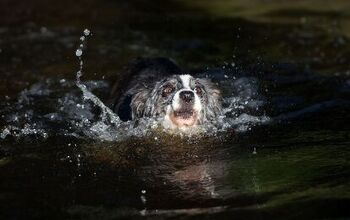How to Stop Begging at the Table

Dinnertime is when you’re supposed to unplug, unwind, and just savor the moment. But if your dog is crying for a bit of your food, jumping up on the table, or pawing at you during your dinner, it’s hard to relax. Want to fix this problem for good? Here’s how.
Why do most dogs beg? Because it works! If anyone in your family gives Fido a piece of pasta or a sliver of steak from the table, it has taught him that begging works. Dogs are always learning, not just during training sessions. This means that every time you slip Fido a chunk of chicken from your fork, you are literally teaching him to beg more. So if you want your dog to keep away from the table, he must never, ever be given food there. It’s your job to teach your pup that begging doesn’t work, no matter how much he persists. What if your have small children who drop food at the table? Though it’s unintentional, Fido will make the same association and will continue to beg.
The easiest management solution, then, is to physically remove your dog from the dining area. Use a gate or fence to prevent him from entering during dinner. If that won’t work, your dog can go into any other safe place: his crate, the backyard, or a bedroom. Or use his leash to tie him to a nearby banister or sturdy table leg (and bring his bed there), so he can watch you eat but can’t participate. If he protests about being removed from the fun, give him his doggie dinner in a food-dispensing toy, which will keep him busy.
There are a few useful training techniques to teach your dog what to do while you’re eating. If your dog has never developed a habit of begging, training your dog to mind his own business during dinner should be simple. On the other hand, it may take some time for those who have a long history of joining you at the table. Stay committed to the training process and understand that it’s really challenging for a dog to resist the temptation of food.
Remember that dogs, by nature, are scavengers. Evolution has favored dogs that are skilled at begging and picking up scraps of food, so we can’t expect your pooch to understand why begging is undesirable. Set your dog up for success by teaching him it doesn’t pay to beg.
Start by teaching your dog a Place cue, which means “go to your bed and stay there until I release you.” The dog bed should be within view of the dining area, so you can monitor your dog. In the beginning, you’ll likely have to get up from the table numerous times to reward your dog for his good behavior, or reset him if he gets up before you release him.
To teach the basic level of Place, choose a mat or bed for your dog to lie on.
- Say “place” and point or lure your dog onto the mat.
- Once all four paws are on the mat, ask him to lie down.
- While he’s lying on the mat, you’ll pause for three seconds (or as long as your dog can remain stable), then drop a treat on the mat between his paws. Repeat this sequence of pausing and treating.
- After several treats, say “okay” and release him from the mat.
- As your dog gets better at this, you will increase the pauses between treats. This will build your dog’s ability to control his impulses and stay on the mat for longer periods of time.
You can practice this while you’re at the dinner table. With consistency, your dog will learn to go to his bed automatically when you sit at the table. After a little while you won’t need to worry about rewarding or resetting anymore. Release him when you’re done eating, and his reward can be permission to check the floor for any (dog-friendly) food you dropped.
A Leave It cue is useful for times when you’ve dropped a piece of food and don’t want your dog to rush over to eat it. (Remember, allowing him to eat it will only make the begging worse.) You can see the steps for a basic Leave It here.
Whether you use management or training, it’s critical for everyone in your household to be consistent. Make a plan in your household for a management and/or training strategy, and stick to it.

Kate Naito, CPDT-KA, is a dog trainer at Doggie Academy in Brooklyn, NY, and author of the training book, "BKLN Manners." She draws upon her experience as an educator and dog trainer to apply positive training techniques to a challenging urban environment. Kate is a rescue advocate drawn to special-needs dogs and currently has two Chihuahua mixes, Batman and Beans.
More by Kate Naito























